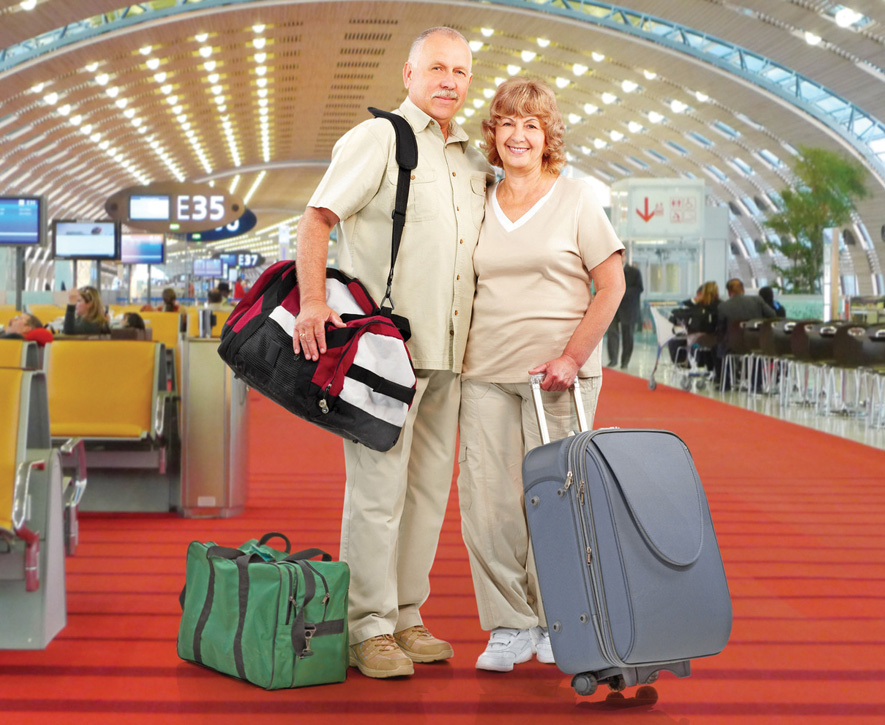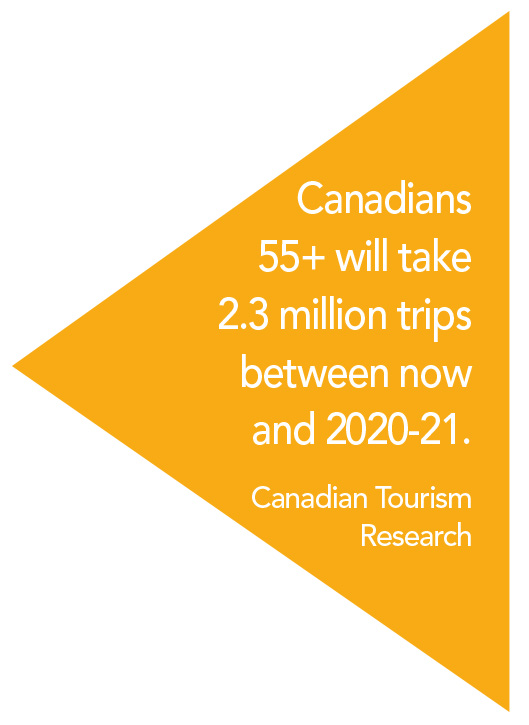Hitting the Road in Comfort and Style
By Pat Irwin
Adventure doesn’t have to stop just because you have a medical condition or need some extra help. If you stay flexible, consider travelling with friends and family rather than alone, pack light, plan carefully and keep your sense of humour then you can still travel the world for business or pleasure. Here are some stories and lessons learned.
 Mary’s costly online booking
Mary’s costly online booking
Mary decided to join her daughter Laura at the end of Laura’s business conference in Palm Springs. What a treat! A long weekend in February in the sun for the two of them why not? In a few clicks, Laura had set it up online, sent her ticket to her mother and made shopping and dinner plans. Who needs a travel agent?
As recommended by her daughter, Mary arrived at the airport with time to spare, but bad weather delayed her first flight and she missed her connection to Palm Springs. To get there in time, Mary ended up paying full-fare for a new ticket rather than staying on standby for the next flight in the morning. A costly solution. Mary hoped she could get her money back from the first airline, but really didn’t know how to start the process.
The solution: Do your research ahead of time. A registered travel agent can navigate the best options, restrictions, fees, changes, exclusions, overbooking and, best of all, provide good advice. Be sure you aren’t dealing with a company who simply resells flights and hotel rooms. The industry is regulated by the Association of Canadian Travel Agencies (acta.ca) and each province has a travel industry council (e.g., the Travel Industry Council of Ontario, tico.ca) that maintains standards, deals with consumer protection, registration and inspection, and investigates and mediates disputes between consumers and registrants. The federal government’s site on travel and tourism (travel.gc.ca) also has excellent general information about international travel.
Some tips:
• Be sure your agent understands your unique needs such as age, mobility, budget, timelines and preferences. You can expect agents to suggest realistic fares, suitable connections, the best possible itineraries and alternatives. Just ask. Travel professionals are also a godsend for planning family trips and save you time sorting through everything yourself. They’ll help with sensible flight times, the shortest travel times, seats together, hotel rooms with enough sleeping space, accessibility options if necessary and a car that can accept a child’s seat if you’re travelling with kids. Ensure there’s a 24-hour help line you can call internationally, in case of emergencies or unexpected problems. And remember the basics: Fly direct, avoid layovers, fly early in the day and consider alternative airports.
Joan needs assistance
When Pam went to pick up her friend Joan at the airport, Joan was escorted into the arrival zone in an airline wheelchair by airport staff—just as they had as planned. The attendant helped Joan to her feet, folded up the chair and wheeled it away, leaving the women on their own with the suitcases. Um—what were they supposed to do now? As always, do your research well in advance, starting with the federal government’s website (travel.gc.ca/travelling/health-safety/disabilities). The site provides excellent information, including tips for travellers with disabilities with a travel countdown and checklist of questions to ask.
Tips for travellers with disabilities:
• Think through your requirements in detail—from getting into the terminal and through check-in and security, to preboarding, mobility while in the aircraft, airport and aircraft washroom facilities, use of any medical equipment (e.g., oxygen) during the flight and wheelchair facilities upon landing. The more comprehensive your list, the more you can prearrange.
Ask your travel agent to avoid connecting flights or be sure to allow at least two hours (if you need to go through customs or security) to get from one gate to the next.
• Confirm all services to be provided by the carrier and check all required documents, such as conditions for attendant travel, supporting medical certification and any additional medications for the trip itself. Ensure adequate supplies of all medications are on hand.
• Contact your doctor for a statement, preferably on letterheaded paper, covering your condition, medications, potential complications, special needs and 24/7 medical contact information. Carry medical alert information, preferably in a place that a medical professional or anyone who assists you will find easily (e.g., wallet card, necklace).
• Make pretravel plans. Two days before your departure, visit the terminal to get acquainted with the layout or search for a floor plan online. Make arrangements to get to the airport, station or terminal.
• On travel day, keep documents and medication in your hand luggage for easy access. Arrive
early enough to allow the carrier to provide you with assistance and confirm your arrangements at the check-in counter. It can be useful to pack a snack in case of travel delays. Confirm your needs with the onboard service personnel after boarding.
• Arrange in advance for an accessible vehicle to pick you up at your destination.
• Stay calm, be positive, stay patient and be sure to thank everyone who helps you!
Travelling with a medical condition
Ann had always wanted to visit Paris, and her diagnosis of chronic obstructive pulmonary disease sealed her decision. Her friends and family tried to dissuade her, but her doctor gave a reluctant thumbs-up. After researching all of the details, Ann’s daughter Sara agreed to go with her. Here are a few of the lessons they learned.
• Plan your trip realistically with a mix of “busy” and “quiet” days. Be very clear with yourtravel agent about your capabilities. Ask your agent to liaise with colleagues at your destination to prescreen medical services and location
• Obtain a “fit to fly” form from your doctor at least a month before your trip. This should include your diagnosis, recent treatments and prognosis.
• Research and reserve assistive devices and support services. Don’t underestimate the amount of walking you will have to do before boarding, and the need for accessible washrooms.
• Get sufficient supplies of prescriptions filled in advance. In some provinces, the limit is a three-month supply; in others, six months—check in advance. Carry the medication in its original container with both generic and brand names. Be sure you can access your medical team 27/4, by phone, email or text.
• Check health coverage. For example, Ontario’s OHIP provides only limited funding while travelling, and usually only if they are acute, unexpected and require immediate treatment. You or your private insurance company will be required to pay upfront for out-of-country treatment at the time of the service and request reimbursement from OHIP, which will be limited to those amounts defined by regulations, and usually only to the cost of the treatment in your home province.
• Travel insurance may indeed be a possibility. Contact your insurance agent well in advance. Even if you have a pre-existing illness, having been deemed “fit to fly” might be a mitigating factor in your favour.
Use this successful trip to remind yourself that you are more than your illness!
Pat Irwin, BA, AICB, CPCA, is President of ElderCareCanada.













